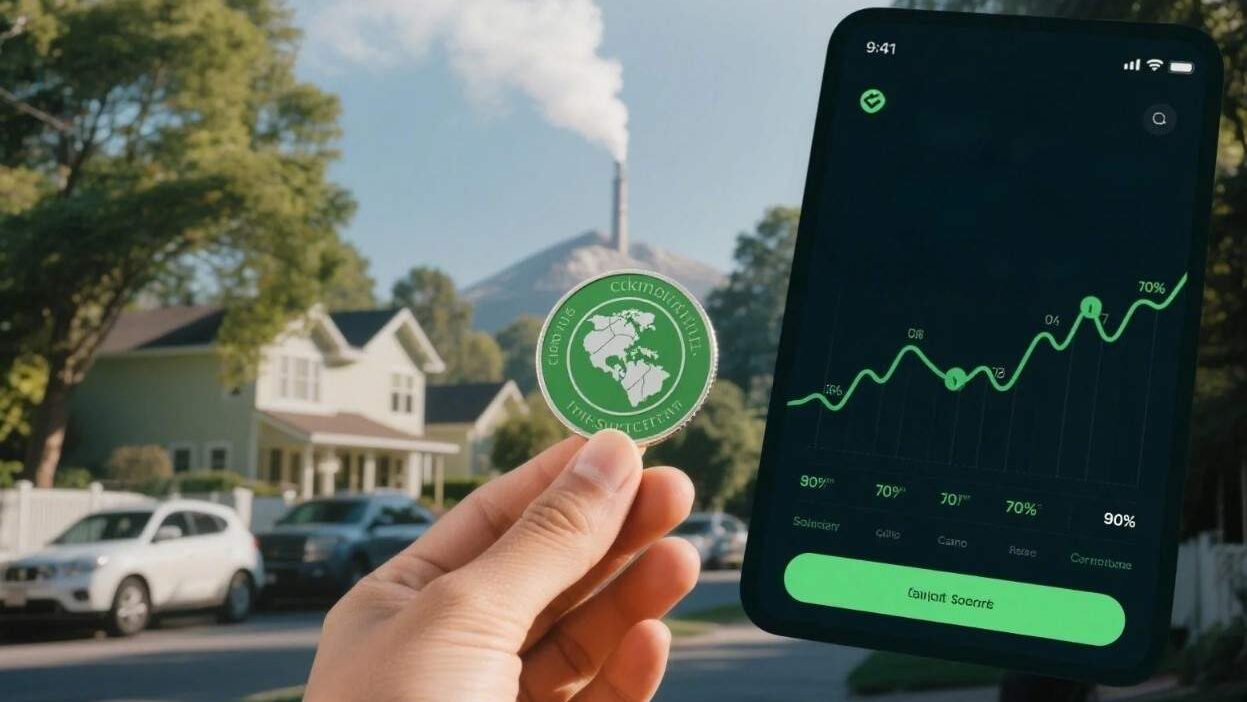Turning Emissions into Actionable Impact
The Power of “I” in Climate Action
Climate change is a collective crisis, but its solutions demand individual accountability. While corporations and governments often shoulder the spotlight, research shows that 70% of global carbon emissions stem from household and personal choices—from driving gas cars to heating homes with fossil fuels. Yet, until recently, tracking and offsetting these personal emissions has been opaque, complex, and disconnected from daily life.
Enter carbon credit tokenization: a revolutionary technology that transforms abstract carbon emissions into tangible, tradable digital assets. By linking individual actions to verifiable carbon credits, this innovation bridges the gap between personal responsibility and global climate goals. This report explores how carbon credit tokenization is empowering individuals to own their carbon footprint—and why it’s the key to unlocking a more sustainable future.
What Are Carbon Credits, and How Does Tokenization Work?
To understand the revolution, we first define two critical terms:
1. Carbon Credits: The Currency of Emission Reduction
A carbon credit is a permit that represents the right to emit 1 ton of CO₂ (or equivalent greenhouse gas). Governments, corporations, or projects (e.g., reforestation initiatives) earn these credits by reducing emissions below regulatory limits or investing in carbon-absorbing projects. Traditionally, credits are traded between entities (e.g., a factory buying credits to offset its emissions), but they’ve rarely been accessible to individuals.
2. Tokenization: Making Credits Tangible
Tokenization converts physical or digital assets (like carbon credits) into blockchain-based tokens. These tokens are:
- Fungible: Each token represents a standardized unit (e.g., 1 ton of CO₂).
- Traceable: Every transaction is recorded on an immutable blockchain ledger.
- Tradable: Users can buy, sell, or redeem tokens on digital marketplaces.
For individuals, tokenization turns abstract “carbon footprints” into visible, ownable assets. Imagine a daily app that tracks your emissions (e.g., from driving, heating, or shopping) and converts them into carbon tokens. If you reduce your footprint, you earn surplus tokens; if you overshoot, you can buy tokens to offset your impact—all in real time.
How Tokenization Drives Individual Accountability
Carbon credit tokenization isn’t just a technical novelty—it’s a behavioral shift. Here’s how it transforms individual responsibility:
1. Transparency: No More “Out of Sight, Out of Mind”
Most people don’t know their daily carbon footprint. A 2023 study by Carbon Trust found that 68% of adults underestimate their emissions by 30% or more. Tokenization solves this by:
- Real-Time Tracking: Apps linked to IoT devices (smart thermostats, car GPS) automatically log emissions and convert them into tokens.
- Visual Dashboards: Users see their “carbon balance” (credits earned vs. spent) in a simple, app-based interface—making emissions as tangible as a bank account.
For example, a user driving a gas car might earn -5 kg CO₂ tokens daily, while biking earns +2 kg. Over time, they see their net balance, motivating them to adjust habits.
2. Incentivization: Rewards for Reducing Emissions
Tokenization turns “doing good” into a reward system. Individuals earn surplus tokens by:
- Adopting energy-efficient habits (e.g., switching to LED bulbs).
- Supporting renewable energy (e.g., buying green electricity).
- Participating in carbon-offset projects (e.g., planting trees via a linked app).
These tokens can be redeemed for:
- Discounts on eco-friendly products.
- Donations to climate charities.
- Access to premium services (e.g., carbon-neutral shipping).
A pilot program by EcoToken in Sweden saw 75% of users increase their recycling habits after earning tokens redeemable for local café discounts.
3. Ownership: Taking Responsibility for One’s Impact
Tokenization shifts the narrative from “corporations must fix climate change” to “I have a role to play.” By owning carbon tokens, individuals:
- Feel Accountable: They see their choices directly impact their token balance.
- Engage Actively: They’re more likely to reduce emissions to avoid “overspending” tokens.
- Advocate: Token holders often become vocal supporters of climate policies, as their personal stake aligns with broader goals.
Benefits: Beyond Individual Action
The ripple effects of carbon credit tokenization extend far beyond personal habits:
1. Market Incentives for Decarbonization
By creating a liquid market for individual carbon tokens, the system incentivizes businesses to reduce emissions. Companies that emit less earn more tokens, which they can sell to individuals or use to meet regulatory requirements. This creates a virtuous cycle: lower emissions → more tokens → higher demand → greater incentive to decarbonize.
2. Bridging the “Green Gap” Between Rich and Poor
Traditional carbon markets often favor corporations or high-income individuals. Tokenization democratizes access: even low-income households can earn tokens by adopting frugal habits (e.g., reducing food waste), empowering them to contribute to climate solutions.
3. Data-Driven Policy Making
Aggregate token data reveals trends in individual emissions (e.g., which regions or demographics have the highest footprints). Governments can use this data to design targeted policies—e.g., subsidies for electric vehicles in high-emission areas.
Challenges and Solutions
While transformative, carbon credit tokenization faces hurdles:
1. Technical Complexity: “Blockchain? I Don’t Get It”
Many individuals lack the technical knowledge to navigate blockchain platforms.
Solution: User-friendly apps (e.g., Carbon Wallet, EcoTrack) simplify the process. These tools auto-track emissions, convert them to tokens, and explain the process in plain language.
2. Regulatory Uncertainty
Laws around carbon markets and cryptocurrency vary globally. Some countries restrict token trading, while others lack frameworks for verifying emissions data.
Solution: Advocacy groups (e.g., the Carbon Credit Tokenization Alliance) are pushing for international standards. The EU’s Carbon Border Adjustment Mechanism (CBAM) already recognizes carbon credits, paving the way for broader acceptance.
3. Risk of Greenwashing
Without rigorous verification, tokenized credits could be inflated or fraudulent.
Solution: Third-party auditors (e.g., Sustainalytics) validate emissions data and token issuance. Blockchain’s immutability ensures records can’t be altered retroactively.
Real-World Examples: Tokenization in Action
1. EcoToken: Sweden’s Carbon Credit Marketplace
EcoToken allows Swedish households to earn tokens by reducing energy use. Users link smart meters to the app, which tracks electricity, heating, and transport emissions. Tokens can be redeemed for discounts on electric cars, solar panels, or donations to reforestation projects. Since launching in 2022, EcoToken has engaged 50,000+ users, reducing household emissions by 12% in pilot areas.
2. Microsoft’s “Carbon Removal Marketplace”
Microsoft’s platform lets individuals purchase carbon removal tokens (backed by projects like direct air capture) to offset their emissions. The system uses blockchain to verify each removal project’s impact, ensuring transparency. In 2023, it processed $10 million in token transactions, funding 500+ tons of CO₂ removal.
3. India’s “Green Points” Program
India’s government tested a blockchain-based “Green Points” system, where citizens earn tokens for sustainable actions (e.g., planting trees, using public transport). Tokens can be redeemed for subsidies on LPG or solar appliances. Early results showed a 20% increase in sustainable behavior among participants.
Ethical Considerations: Ensuring Equity and Trust
For carbon credit tokenization to succeed, it must prioritize fairness:
- Avoid Disproportionate Burdens: Low-income individuals shouldn’t face penalties for unavoidable emissions (e.g., heating a home in winter). Tokens should reward reductions, not penalize baseline needs.
- Protect Privacy: Emissions data (e.g., travel patterns) must be anonymized to prevent misuse.
- Combat Fraud: Rigorous audits and blockchain’s immutability are critical to maintaining trust.
The Future: Scaling Individual Accountability
The future of carbon credit tokenization is bright, with innovations on the horizon:
- AI-Driven Insights: Machine learning could analyze token data to predict emission trends, helping users and policymakers target interventions.
- Integration with Mainstream Finance: Tokenized carbon credits could be listed on stock exchanges, attracting institutional investors and boosting liquidity.
- Global Coalitions: Projects like the Global Carbon Credit Alliance are uniting countries to standardize tokenization, making it easier for individuals worldwide to participate.
Your Carbon Footprint, Your Responsibility
Carbon credit tokenization isn’t just about technology—it’s about empowerment. By turning emissions into tangible, tradable assets, it gives individuals the tools to own their impact, make informed choices, and drive collective change.
Climate change won’t be solved by corporations or governments alone. It requires you—and me—to take action. With carbon credit tokenization, that action is easier, more visible, and more impactful than ever.
The question now is: What’s your first step to reducing your carbon footprint?


